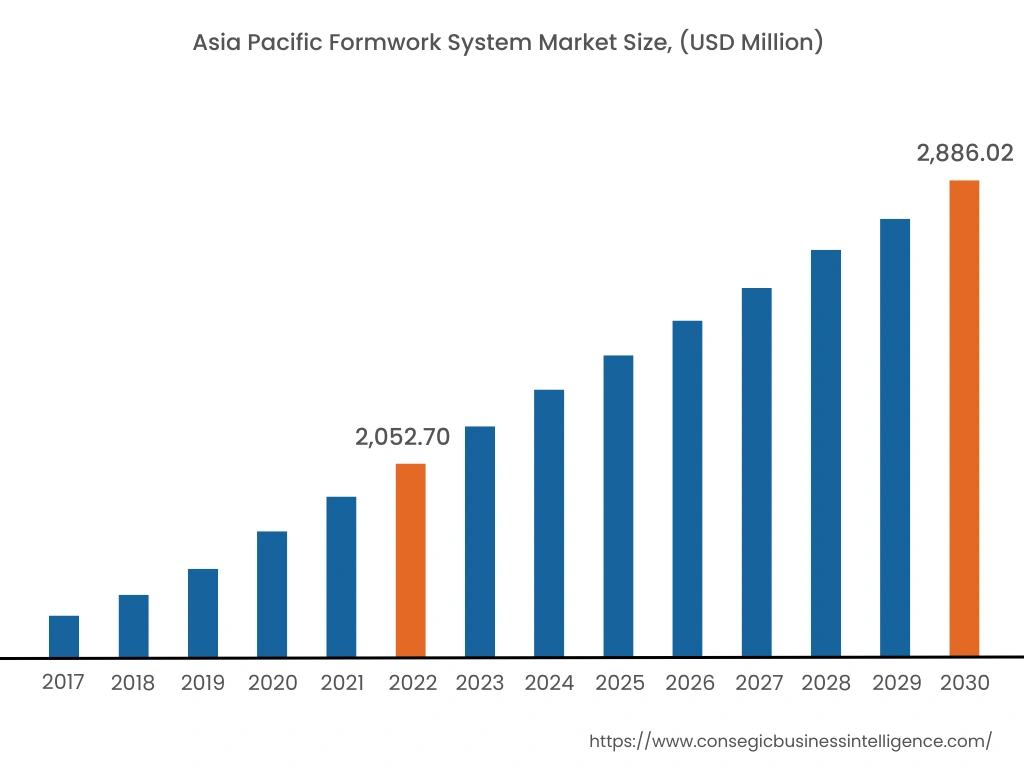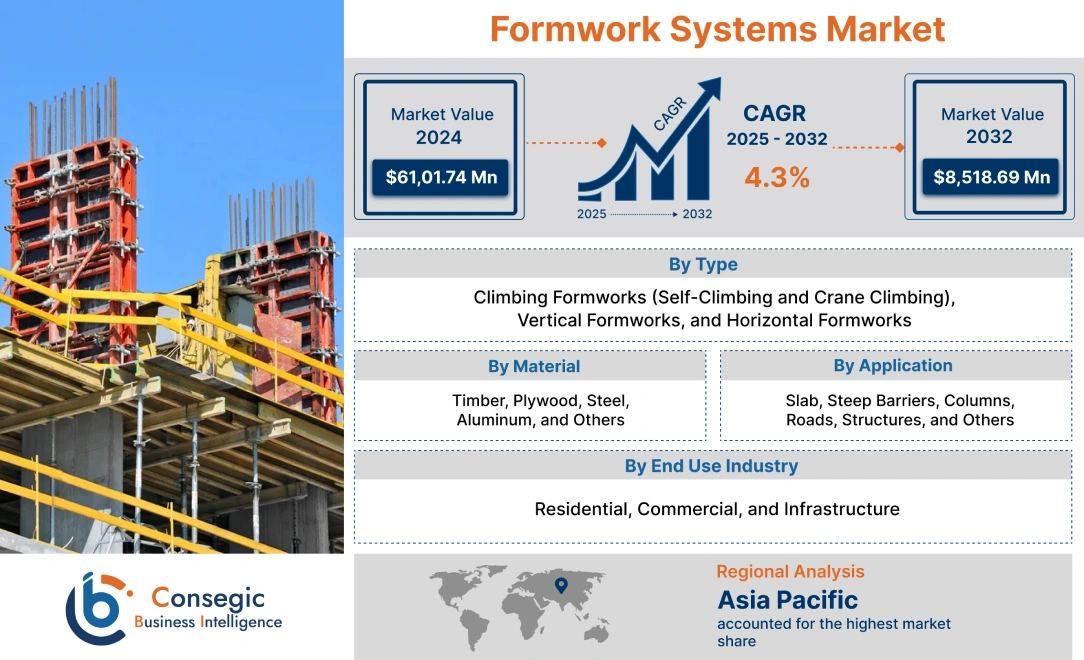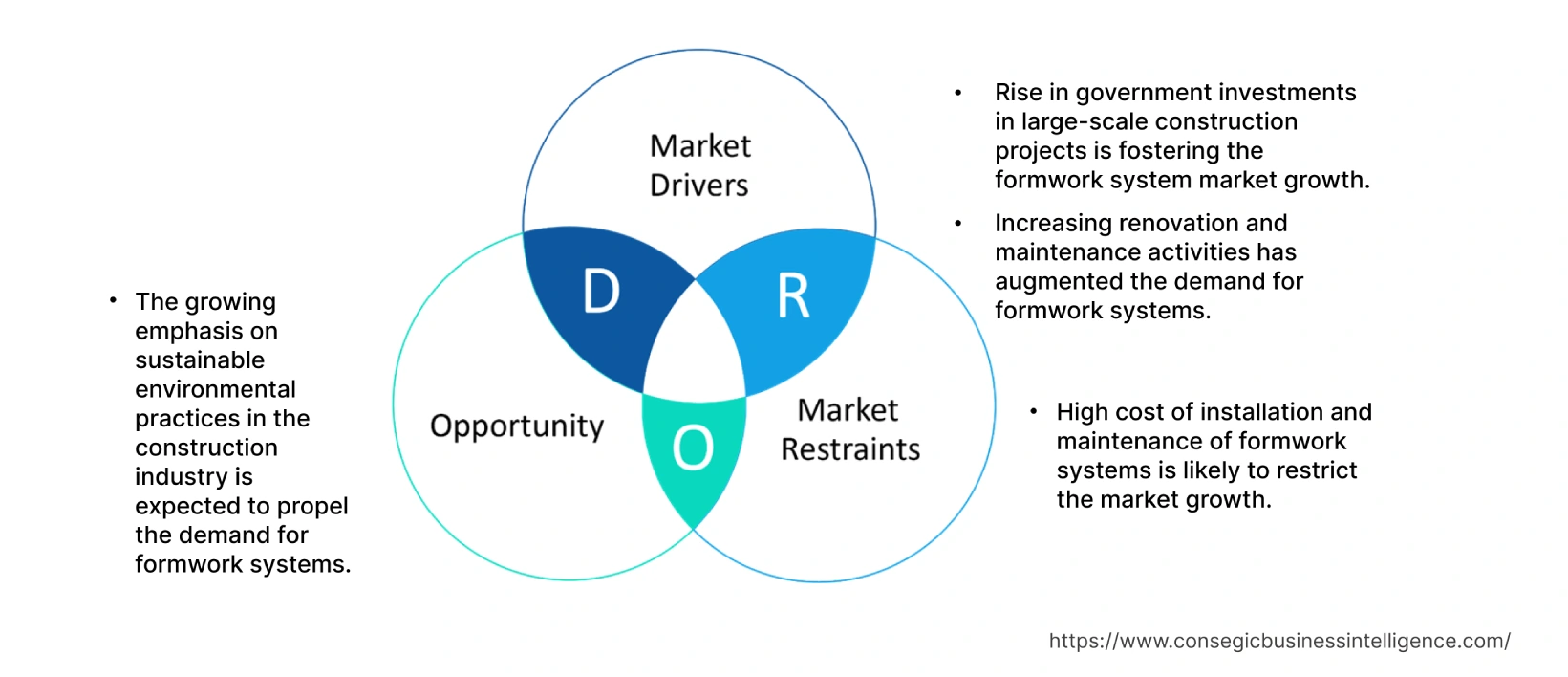- Summary
- Table Of Content
- Methodology
Formwork Systems Market Introduction :
Consegic Business Intelligence analyzes that the Formwork Systems Market size is estimated to reach over USD 8,518.69 Million by 2032 from a value of USD 6,101.74 Million in 2024 and is projected to grow by USD 6,252.95 Million in 2025, growing at a CAGR of 4.30% from 2025 to 2032.
Formwork Systems Market Definition & Overview:
Formwork systems refer to temporary structures used to support and shape concrete in the construction process. These systems can be made of various materials such as timber, steel, aluminum, or plastic, depending on the requirement. They are designed to withstand the pressure exerted by fresh concrete and any additional loads during construction. Furthermore, formwork systems are essential for creating various concrete elements, including walls, columns, slabs, and other structural components in building and infrastructure projects.
Formwork Systems Market Insights :
Key Drivers :
Rise in government investments in large-scale construction projects is fostering the formwork system market growth
Large scale government projects such as bridges, tunnels, and high-rise buildings require formwork systems for shaping and supporting the concrete during the construction process. Governments investments are contributing to a surge in construction activities and subsequently increasing the demand for formwork systems. For instance, according to the report published by the India Brand Equity Foundation, in December 2022, AAI and other Airport Developers have targeted a capital outlay of approximately USD 11.8 billion in the airport sector in the next five years for expansion and modification of existing terminals, new terminals and strengthening of runways, among other activities. As a result, the expansion of the infrastructure sector is a significant factor driving the formwork system market growth.
Increasing renovation and maintenance activities has augmented the demand for formwork systems
Many existing structures such as bridges, highways, and buildings require renovation and maintenance to expand their lifespan. Formwork systems facilitate these modifications and ensure the structural integrity of the renovated elements. The rise in government funding and investments for the maintenance and preservation of highways, bridges, and tunnels is a significant factor contributing to the growing demand for formwork systems. For instance, in October 2022, the Federal Highway Administration (FHWA) announced USD 20 million in bridge planning grants for 24 projects in the United States. Further, according to a 2020 report by the U.S. Government Accountability Office (GAO), 54% of U.S. school districts need to update or completely replace multiple building systems in their schools. Hence, the increasing need for infrastructure renovation is another influencing factor propelling the demand for formwork systems.
Key Restraints :
High cost of installation and maintenance of formwork systems is likely to restrict the market growth
The high cost of installation and maintenance can limit the adoption of formwork systems, particularly for smaller or budget-constrained projects in the construction industry. In addition, regular maintenance and proper storage of formwork systems are essential to ensure their safety and longevity. These activities add up to the overall expenses. Further, setting up and dismantling formwork can be time-consuming, leading to increased labor costs and potential project delays. Hence, the aforementioned factors may restrict some construction companies from using formworks, in turn deterring market growth.
Future Opportunities :
The growing emphasis on sustainable environmental practices in the construction industry is expected to propel the demand for formwork systems
The use of eco-friendly materials in formwork systems, such as recycled timber, sustainable composites, or reusable metal panels is on the rise to reduce environmental impact and carbon footprint. The rising awareness among consumers and growing emphasis on sustainable construction practices is expected to accelerate market growth. Furthermore, new regulations such as the Construction Products Regulation (CPR) and the European Green Deal are demanding increased environmental measures for how projects are designed, constructed, and maintained. Thus, the increase in government implementations for stringent environmental regulations in construction projects is a major factor that is anticipated to surge the demand for eco-friendly formwork systems.
Formwork Systems Market Report Insights :
| Report Attributes | Report Details |
| Study Timeline | 2019-2032 |
| Market Size in 2032 | USD 8,518.69 Million |
| CAGR (2025-2032) | 4.3% |
| By Type | Climbing Formworks (Self-Climbing and Crane Climbing), Vertical Formworks, and Horizontal Formworks |
| By Material | Timber, Plywood, Steel, Aluminum, and Others |
| By Application | Slab, Steep Barriers, Columns, Roads, Structures, and Others |
| By End-use Industry | Residential, Commercial, and Infrastructure |
| By Region | North America, Europe, Asia-Pacific, Latin America, Middle East & Africa |
| Key Players | Doka GmbH, MEVA, ULMA Group, EFCO Corp., SH, Suzhou TECON Construction Technology Co., Ltd., URTIM Formwork and Scaffolding Systems, Total Contec, Brand Industrial Services, Inc., PERI SE, KHK Scaffolding & Formwork LLC (Taurani Holdings Ltd, Dubai), Nova Formworks |
Formwork Systems Market Segmental Analysis :
Based on the Type :
The type segment is categorized into climbing formworks, vertical formworks, and horizontal formworks. In 2024, the horizontal formworks segment accounted for the highest market share in the formwork system market. Horizontal formworks can be used for various structures such as floors, slabs, and beams. The growth of the segment is attributed to the versatility and time and cost efficiency. These systems enable faster construction and reduce labor costs due to their ease of installation and removal.
However, the vertical formworks segment is expected to grow at the fastest CAGR during the forecast period. Rapid urbanization has led to an increasing need for the construction of high-rise buildings, bridges, and infrastructure, driving the demand for vertical formwork systems that facilitate efficient and safe construction processes. Further, the rise in rising government initiatives for infrastructure development is a significant factor fostering segment growth. For instance, according to the report published by the India Brand Equity Foundation, in 2022, the government of India allocated USD 17.24 billion to the National Highways Authority of India (NHAI).
Based on the Material :
The material segment is categorized into timber, plywood, steel, aluminum, and others. In 2024, the timber segment accounted for the highest market share in the overall formwork system market. The key factor fostering segment growth is the cost-effectiveness of timber formwork systems. These types of systems are adaptable and can be easily customized to fit various construction designs and shapes. In addition to this, the local availability of timber in many regions is another influencing factor propelling the segment growth.
However, the aluminum segment is anticipated to grow at the fastest CAGR during the forecast period. Aluminum is a lightweight material, resistant to corrosion and wear. Moreover, aluminum is recyclable, making it an eco-friendly choice for construction projects that aim to reduce environmental impact and promote sustainable practices. The reusability of these systems reduces the need for new formwork systems, making them ideal for multiple construction projects. Therefore, the above mentioned benefits are likely to surge product demand in the following years.
Based on the Application :
The application segment is categorized into slabs, steep barriers, columns, roads, structures, and others. In 2024, the structures segment accounted for the highest market share of 28.87% and is also anticipated to grow at the fastest CAGR during the forecast period. The global increase in construction projects, including high-rise buildings, bridges, and infrastructure development has generated a high demand for efficient and versatile formwork systems. For instance, according to the statistics published by the Associated General Contractors (AGC) of America, the construction industry in the U.S. creates nearly USD 1.8 trillion worth of structures each year.

Based on the End-Use-Industry :
The end-use industry segment is categorized into residential, commercial, and infrastructure. In 2024, the residential segment accounted for the highest market share in the overall formwork system market. Formwork systems offer efficient and speedy construction methods that are crucial for residential structures. The demand for residential properties has surged due to increased urbanization and rising household income. For instance, according to estimates from the National Association of Building Contractors (ANCE), investments in the construction of new housing rose 12% compared to 2020 in Italy.
However, the infrastructure segment is anticipated to grow at the fastest CAGR during the forecast period. The growth of the segment is attributed to rising infrastructure development projects across the globe. Moreover, an increase in government and private investments in development as well as upgrading roads, bridges, railways, airports, and other essential facilities is another prominent factor accelerating the demand for formwork systems. For instance, as per the report published by Airports Council International, the redevelopment and expansion of terminals of JFK International Airport, the terminal expansion project at the Southwest Florida International Airport, among others are initiatives taken to modernize America's airports. As a result, the rise in infrastructure development will aid to surge the demand for formwork systems in the construction process.
Based on the Region :
The regional segment includes North America, Europe, Asia Pacific, the Middle East and Africa, and Latin America.

Asia Pacific region was valued at USD 1,797.01 Million in 2024. Moreover, it is projected to grow by USD 1,846.75 Million in 2025 and reach over USD 2,593.94 Million by 2032. In the Asia Pacific region, China accounted for the highest market share of 29.45% during the base year 2024 owing to the significant growth in infrastructure projects and rapid urbanization in the region. For instance, according to the 2022 report published by the Airports Council International (ACI) Asia-Pacific, Asia-Pacific accounts for 80% (USD 579 billion) of the global greenfield airport investments in the next two decades, driven by the rapid growth in passenger demand for air transport, predominantly in India and China. Similarly, governments in Vietnam, Philippines, and Indonesia are constructing dozens of new airports to connect islands with geographically challenging areas. As a result, the developments in air transport infrastructure are accelerating the demand for formwork systems in the region.
However, North America is expected to grow at the fastest CAGR of 5.9% over the forecast period. Increased investment in infrastructure development and technological developments in building materials for residential and commercial construction is likely to create lucrative opportunities for the key players operating in the formwork system market. For instance, according to the report published by the U.S. Bureau of Economic Analysis (BEA), infrastructure produced USD 1.17 trillion in gross output in 2021. The growth in real gross output between 2020 and 2021 accounted for 11.1%.

Top Key Players & Market Share Insights:
The formwork system market is highly competitive, with several large players and numerous small and medium-sized enterprises. These companies have strong research and development capabilities and a strong presence in the market through their extensive product portfolios and distribution networks. The market is characterized by intense competition, with companies focusing on expanding their product offerings and increasing their market share through mergers, acquisitions, and partnerships. The key players in the market include -
- Total Contec
- Brand Industrial Services, Inc.
- PERI SE
- KHK Scaffolding & Formwork LLC (Taurani Holdings Ltd, Dubai)
- Nova Formworks
- Doka GmbH
- MEVA
- ULMA Group
- EFCO Corp.
- SH
- Suzhou TECON Construction Technology Co., Ltd.
- URTIM Formwork and Scaffolding Systems
Recent Industry Developments :
- In September 2021, MEVA acquires Acropol Group, a formwork and shoring tower rental company.
- In January 2023, PERI acquired Implenia Schalungsbau GmbH and the company is managed under the name PERI Schalungsbau GmbH as a subsidiary of PERI Germany.
Key Questions Answered in the Report
What was the market size of the formwork system market in 2024? +
In 2024, the market size of formwork system was USD 6,101.74 million.
What will be the potential market valuation for the formwork system market by 2032? +
In 2032, the market size of formwork system is expected to reach USD 8,518.69 million.
What are the key factors driving the growth of the formwork system market? +
The rise in government investments in large-scale construction projects is fostering the formwork system market growth.
What is the dominant segment in the formwork system market by type? +
In 2024, the horizontal formworks segment accounted for the highest market share in the overall formwork system market.
Based on current market trends and future predictions, which geographical region will have the fastest impact on the formwork system market's growth in the coming years? +
North America is expected to be the fastest-growing region in the market during the forecast period.


